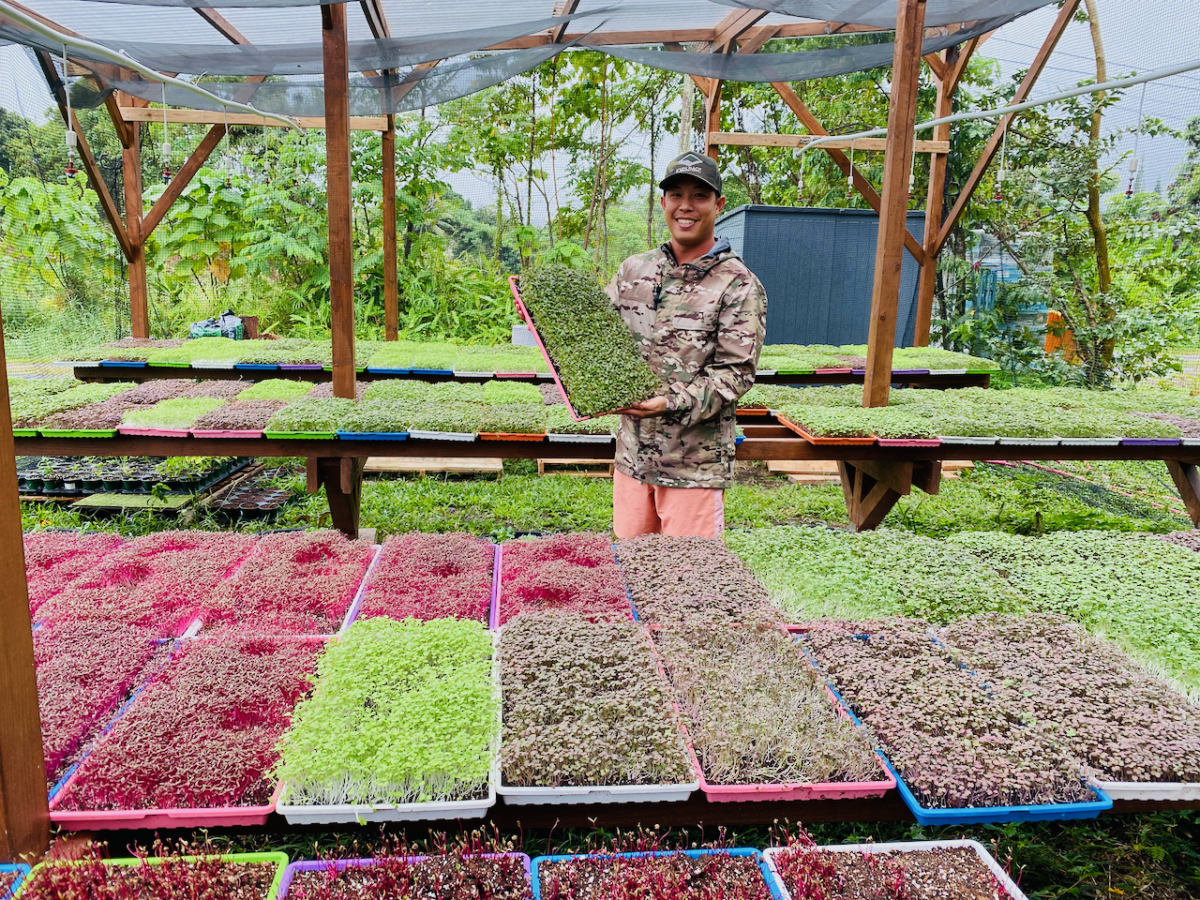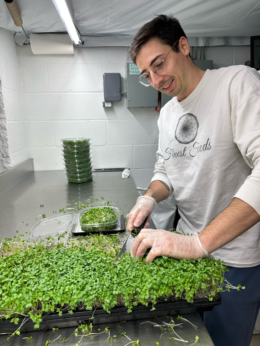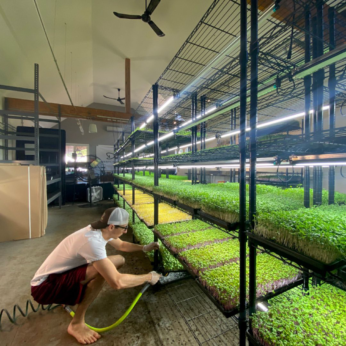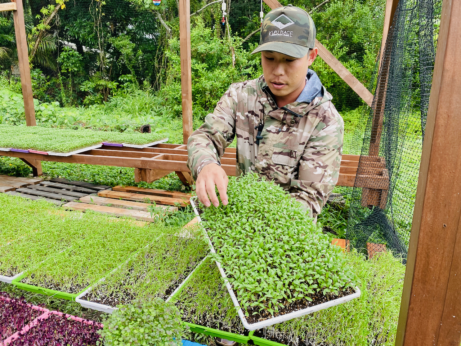Cultivating Profits in a Compact Crop
Microgreens are helping farmers reap greener returns without many of the challenges of agriculture
Cultivating Profits in a Compact Crop
Microgreens are helping farmers reap greener returns without many of the challenges of agriculture

Microgreens growing at Kupu Place.by Naoki Nitta
Basements and garages have long been fertile ground for innovation, with a host of well-known companies including Apple, Amazon and Harley-Davidson tracing back to humble residential roots.
Recently, these unassuming spaces are cultivating a new trend in home-grown businesses. Armed with little more than ingenuity and entrepreneurial drive, microgreen growers are transforming the unused corners of their dwellings into profitable farming operations.
Using minimal inputs and resources such as water, energy and land, microgreens can offer a consistent and hyperlocal source of fresh, nutrient-dense produce, especially in urban settings. And done right, they allow farmers to reap a meaningful livelihood—an important consideration in a profession known for grueling demands and razor-thin margins.
“It’s a great gateway crop,” says Don DiLillo, owner of Finest Foods in Huntington, New York, for ushering in a new breed of novice farmers. After finishing college seven years ago, the “video game-playing, beer-drinking kid” dusted off a section of his parents’ Long Island cellar to launch his micro farm. With $3,000 allocated for equipment and many hours spent watching YouTube tutorials, he built a steady farmers market following, selling tender, week-old pea, sunflower, radish and broccoli sprouts.
Now 27, DiLillo has seen his business blossom. After expanding to a vacant neighborhood deli in 2019, he’s since set up shop in his grandparents’ former home, which he shares with his girlfriend and fellow farmer, Alissa Yasinsky. The 800-square-foot basement and garage provide ample space for germination, cultivation and packaging, he says, with the vertical shelf configuration leaving plenty of room to grow. “I could triple [production] and still be able to operate it from my home,” says DiLillo.
Given the cost of Long Island real estate, the space efficiency is “one of the great benefits of [farming] microgreens,” says DiLillo. Plus, he adds, “I can do farm chores in my pajamas.”

Small footprint, big potential
“Microgreens” is a term used to describe the tender, edible seedlings of various herbs, vegetables and grains typically seeded in shallow, soil-filled trays, grown under natural or artificial light, then harvested within two weeks of germination. Packed with vivid colors, a fresh crunch and intense flavors that can range from sweet to peppery, San Francisco chefs popularized them in the 1980s to liven up fancy dishes.
Although the specialty greens have maintained their trendy reputation, research has also shed light on their health benefits, finding that the nutrient density of sprouts is often higher than that of mature plants. And because they grow quickly with minimal resources—and without herbicides or pesticides—scientists point to their potential to help bolster nutritional security, hedge against disruptions in the food supply chain and even generate fresh produce on long-term space missions.
Retired army veteran Gerry Mateo started farming microgreens in the garage of his Bakersfield, California home as a way to combat anxiety and depression. It’s proven to be a calming and grounding endeavor, he says, and it has also helped improve his diet.
When he launched FilAm Vets Hydroponics Farm in 2021, Mateo was overweight and suffering from high blood pressure and diabetes, he says. But a daily dose of his own fresh produce has made him much healthier and lowered his cholesterol. “You can only eat lettuce in a salad or sandwich,” he says. Microgreens are highly versatile, pairing well with—but not overpowering—various dishes and blending easily into smoothies.
Mateo, who also farms leafy vegetables such as basil, kale and arugula hydroponically, was surprised to find high demand for his produce—especially given his Central Valley location. Yet with California’s agricultural hub dominated by large-scale farms and commodity crops, he’s found a comfortable niche at his local farmers market.
Customers now include nearby restaurants, and with business booming, he’s put a 10-by-20-foot greenhouse in the backyard and hopes to upgrade to a larger vertical farming structure in the near future. With arable land at a premium—urban sprawl is a growing threat to the farming region—“I’m lucky to have a big yard,” says Mateo.
Over the last decade, the appeal of consistent and efficient crop production—made increasingly so by precision technology, AI platforms and data analytics—has spurred a boom in Controlled Environment Agriculture (CEA). By regulating temperature, humidity and light in an enclosed space, CEA structures, which can include everything from tunnel houses to warehouses, can pump out a reliable stream of fresh produce regardless of season, weather or location, often using far less water, soil and inputs than traditional farming.
Despite promises of fortifying and climate-proofing local food production, however, not everybody is convinced about the sustainability of CEA, particularly at scale. Critics equate large ventures to indoor agribusiness: Often backed by companies and private investors with little experience in commercial agriculture, some factory-like facilities can span multiple acres and consume vast amounts of energy. Opponents also question the taste, nutritional value and long-term health implications of crops grown in this artificial setting.

But for micro producers, their environmental impacts match their minimal footprint, says DiLillo, of Finest Foods. His energy costs, for instance, are nominal: Although New York ranks among the most expensive states for electricity, his monthly bill, which covers both home and farm, hovers around $300 in the winter and doubles in the summer with air conditioning—in line with the national household average of $430 a month. And with weekly deliveries contained in a 20-mile radius, his transport footprint is super light, he notes.
DiLillo has also focused on eliminating the sore spot of retail microgreens: plastic packaging. He dropped single-use clamshell boxes for a biodegradable and compostable, plant-based alternative, and he even closed his health food store accounts, which require water-resistant adhesive labels. His subscription-based residential customers and chefs don’t miss the vinyl stickers, he says, because “they know exactly what they’re getting every week.”
As for the artificial environment, “I’m not here to tell you that [LED] lights are better than the sun,” says DiLillo. Yet, “the beauty of microgreens comes from the seeds,” he adds, noting that the just-germinated sprouts retain much of their seminal nutrients, thriving under artificial light in the short duration before harvest.

The local edge
Hawaii’s year-round temperate climate, however, is ideal for farming microgreens outdoors. Cousins Anthony Mau and Steven Yee established Kupu Place in 2017 as a side gig in the backyard of their family home in Honolulu. (Kupu is Hawaiian for sprout; the property is located on Kupu Place.) Given the sliver of land—about a 16th of an acre—the duo initially had doubts about the business’ profitability. But armed with advanced degrees in agricultural sciences, they started with aquaponics, growing leafy vegetables in tilapia tanks, adding hydroponically grown edible flowers before expanding to microgreens.
“Per square foot, it’s obvious which one is more profitable,” says Mau.
As Kupu’s revenues moved into the black, the space limitations became more apparent. Two years ago, after a grueling search in Oahu’s tight real estate market, the cousins landed on a residential property in Kahaluu, on the island’s windward coast. Once home to orchid farms, the neighborhood, which lies about half an hour from downtown Honolulu, still retains a rural air, complete with roaming chickens, despite an influx of residential development. Because the sellers wanted to keep the land productive, Mau thinks it made their offer attractive.
The 1.5-acre lot has ample space for the growing business. Along with the home that Mau and his wife share with Yee (luckily, “it wasn’t a tear-down,” says Mau), there’s a storage room with refrigerators, sinks and germination shelves, while the yard has two 20-by-40-foot shade houses with room for another. Naturally vented and sunlit, the wooden structures display a colorful patchwork of microgreens in local flavors such as red shiso, lemon balm and tatsoi.
Although Kupu’s competition comes from California, on-island production gives the business a tremendous edge, says Mau. Along with lead times of hours instead of weeks, they’re able to accommodate last-minute orders and high levels of customization. And with nearly 90 percent of Hawaii’s food consumption reliant on imports, any boost in homegrown crops for the local market benefits the state’s food security, says Mau.
Since the move, Kupu has become Mau’s full-time endeavor (Yee still runs his landscaping company), and, at 32, he’s in it for the long haul. Microgreen farming is particularly suited to career longevity, he says, as farming at waist height is simply more manageable.
Kaʻinapu Cavasso agrees. One of Kupu’s two employees, she started orchard farming at 16. But the constant repetition of bending down to plant, weed and set up irrigation and looking up to prune trees and harvest fruit became taxing, she says. Now 20, her new job is “a lot more mellow, ergonomic and efficient,” she says. “I love farming…so I hope to [continue] this for a long time.”
Follow us
This work is licensed under a Creative Commons Attribution-NoDerivatives 4.0 International License.
Want to republish a Modern Farmer story?
We are happy for Modern Farmer stories to be shared, and encourage you to republish our articles for your audience. When doing so, we ask that you follow these guidelines:
Please credit us and our writers
For the author byline, please use “Author Name, Modern Farmer.” At the top of our stories, if on the web, please include this text and link: “This story was originally published by Modern Farmer.”
Please make sure to include a link back to either our home page or the article URL.
At the bottom of the story, please include the following text:
“Modern Farmer is a nonprofit initiative dedicated to raising awareness and catalyzing action at the intersection of food, agriculture, and society. Read more at <link>Modern Farmer</link>.”
Use our widget
We’d like to be able to track our stories, so we ask that if you republish our content, you do so using our widget (located on the left hand side of the article). The HTML code has a built-in tracker that tells us the data and domain where the story was published, as well as view counts.
Check the image requirements
It’s your responsibility to confirm you're licensed to republish images in our articles. Some images, such as those from commercial providers, don't allow their images to be republished without permission or payment. Copyright terms are generally listed in the image caption and attribution. You are welcome to omit our images or substitute with your own. Charts and interactive graphics follow the same rules.
Don’t change too much. Or, ask us first.
Articles must be republished in their entirety. It’s okay to change references to time (“today” to “yesterday”) or location (“Iowa City, IA” to “here”). But please keep everything else the same.
If you feel strongly that a more material edit needs to be made, get in touch with us at [email protected]. We’re happy to discuss it with the original author, but we must have prior approval for changes before publication.
Special cases
Extracts. You may run the first few lines or paragraphs of the article and then say: “Read the full article at Modern Farmer” with a link back to the original article.
Quotes. You may quote authors provided you include a link back to the article URL.
Translations. These require writer approval. To inquire about translation of a Modern Farmer article, contact us at [email protected]
Signed consent / copyright release forms. These are not required, provided you are following these guidelines.
Print. Articles can be republished in print under these same rules, with the exception that you do not need to include the links.
Tag us
When sharing the story on social media, please tag us using the following: - Twitter (@ModFarm) - Facebook (@ModernFarmerMedia) - Instagram (@modfarm)
Use our content respectfully
Modern Farmer is a nonprofit and as such we share our content for free and in good faith in order to reach new audiences. Respectfully,
No selling ads against our stories. It’s okay to put our stories on pages with ads.
Don’t republish our material wholesale, or automatically; you need to select stories to be republished individually.
You have no rights to sell, license, syndicate, or otherwise represent yourself as the authorized owner of our material to any third parties. This means that you cannot actively publish or submit our work for syndication to third party platforms or apps like Apple News or Google News. We understand that publishers cannot fully control when certain third parties automatically summarize or crawl content from publishers’ own sites.
Keep in touch
We want to hear from you if you love Modern Farmer content, have a collaboration idea, or anything else to share. As a nonprofit outlet, we work in service of our community and are always open to comments, feedback, and ideas. Contact us at [email protected].by Naoki Nitta, Modern Farmer
January 15, 2024
Modern Farmer Weekly
Solutions Hub
Innovations, ideas and inspiration. Actionable solutions for a resilient food system.
ExploreExplore other topics
Share With Us
We want to hear from Modern Farmer readers who have thoughtful commentary, actionable solutions, or helpful ideas to share.
SubmitNecessary cookies are absolutely essential for the website to function properly. This category only includes cookies that ensures basic functionalities and security features of the website. These cookies do not store any personal information.
Any cookies that may not be particularly necessary for the website to function and are used specifically to collect user personal data via analytics, ads, other embedded contents are termed as non-necessary cookies.